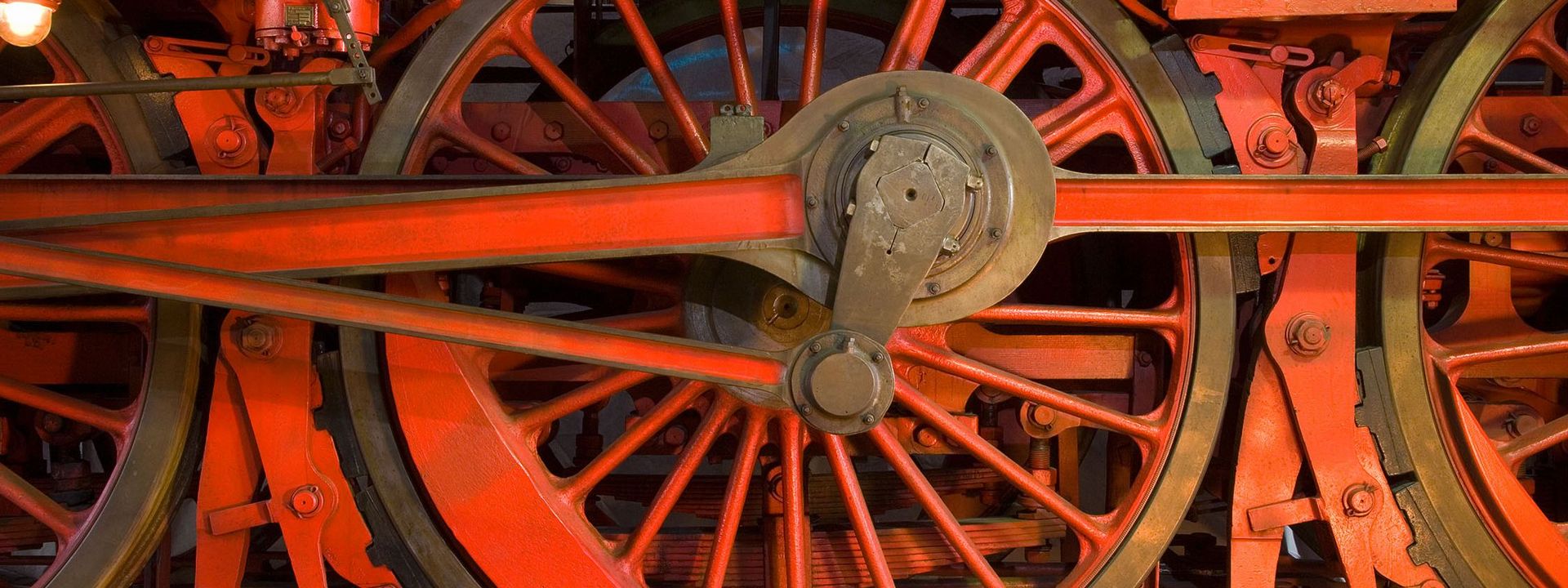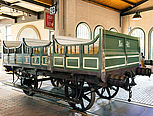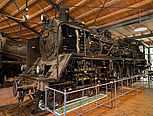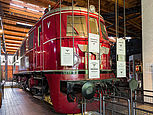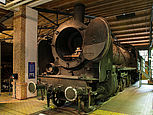Engine shed 1 is open again!
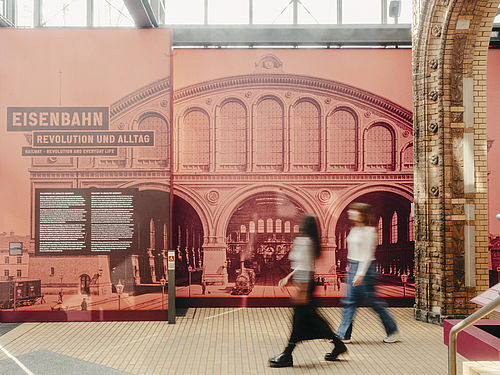
SDTB / Ériver Hijano
The new permanent exhibition on Rail Transport has reopened under the title "Railway: Revolution and Everyday Life". In the historic engine shed, colorful exhibition islands structure the tour. Media installations and interactive stations invite visitors to discover the history of key objects in animated films. The first phase of the revised exhibition, which has now been completed, covers the period from the beginnings of the railroad 200 years ago to 1914.
It shows how rail transport fundamentally and forever changed the lives of all people. For example, the railroad made major migration movements possible and created the time zones. The focus is always on the museum's unique collection, which includes the oldest preserved streetcar: a Berlin horse-drawn carriage from 1865.
Supported with funds from the Lotto Foundation Berlin.
Next Stop: Anhalter Bahnhof
Anhalter Bahnhof was the largest of prewar Berlin’s legendary terminus stations. Its monumental head house was demolished after suffering damage in World War II – all except for a small fragment on Askanischer Platz. Other elements of the structure are now preserved in the Deutsches Technikmuseum, such as the so-called Fürstenportal. This “princely portal” led into the waiting room for “gentlemen of the very highest class and quality.” Today the portal leads into two historic historic engine sheds, or roundhouses, dating to 1874, where the Museum presents 150 years of railroad history over 6,000 square meters of exhibition space. Along with their outdoor turntables, the roundhouses themselves are the largest exhibit, standing as a monument to the complex infrastructure that was necessary to operate the railway system.
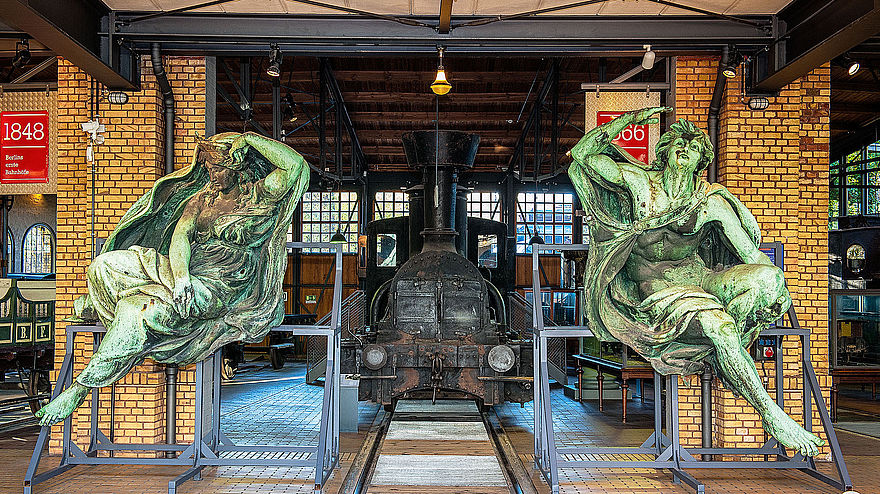
SDTB / C. Kirchner
The Smell of Soot and Oil
Forty original railway vehicles, some of which still exude the smell of soot and oil, make up the heart of the exhibition. In addition, there are many unique, highly detailed models of railroad cars and locomotives on display. These models, built to a scale of 1:5, were made around 1900 by apprentices aiming to qualify as journeymen. The vehicles – both models and originals – are displayed alongside a variety of exhibits illustrating what it was like to work and travel on trains, as well as what place trains had in the popular imagination: train compartments, souvenirs, uniforms, dining car tableware, suitcases, tickets, and toy trains.
The exhibition proceeds chronologically, from the 18th-century predecessors to the railroad, to an open passenger car from 1843 – one of the oldest of its kind still in existence – down to the locomotives and cars of the West German economic miracle and of East Germany. Visitors can walk underneath a locomotive and climb up into the cab and play engineer.
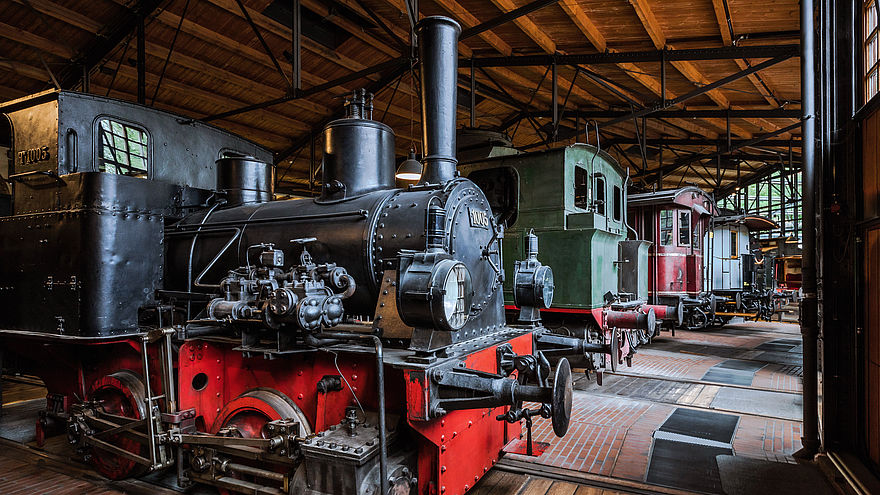
SDTB / H. Hattendorf
Wilhelm II, the “Traveling Emperor”
The history of the German railroad system was closely linked to social and political developments. Thus the exhibition highlights the connection specific people had to trains. For example, Wilhelm II’s parlor car provides insight into his derisive nickname Reisekaiser, or “the traveling emperor.” Otto von Bismarck, on the other hand, symbolizes the fierce debate over the unification of the Reichseisenbahn (German Imperial Railway) that took place in the 1870s.
Holocaust Trains
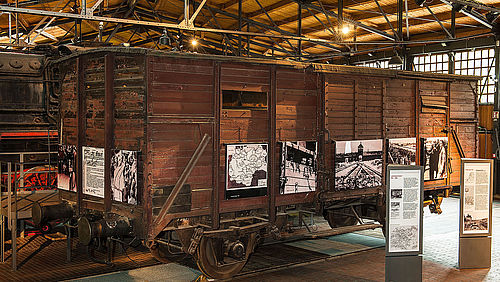
SDTB / C. Kirchner
The Holocaust is also remembered in the exhibition: more precisely the decisive role the Reichsbahn played in the murder of European Jews in the “Third Reich". A boxcar symbolizing the deportations is the centerpiece of an exhibit called “Deportation of the Jews”. It relates the fate of 12 people from Berlin, telling their stories by means of photographs, maps, and train schedules.
There are regular demonstrations of this model of the “Anhalter Bahnhof” train station. Miniature vehicles from the 1930s bring the detailed model to life.
SDTB / H. Hattendorf
Railroad vehicles are put on the right track by a turntable and brought into the Engine Shed, also called a roundhouse, through large gates.
SDTB / C. Kirchner
This cab of an S-Bahn power car from 1927 evokes the introduction of the metro system, circular railway, and suburban lines in Berlin after World War I. Just like today’s S-Bahn trains, it was powered by a third rail developed specifically for this purpose.
SDTB / H. Hattendorf
Young visitors to the exhibition are invited to explore the cab of this Class 50 freight locomotive.
SDTB / F. Grosse
This beam engine was made by the Borsig company in the 19th century. It paved the way for steam power units of all kinds.
SDTB / H. Hattendorf
A passageway underneath the tracks make it easy to see how the bottom of a locomotive looks.
SDTB / H. Hattendorf
“Next Stop: 1900!”
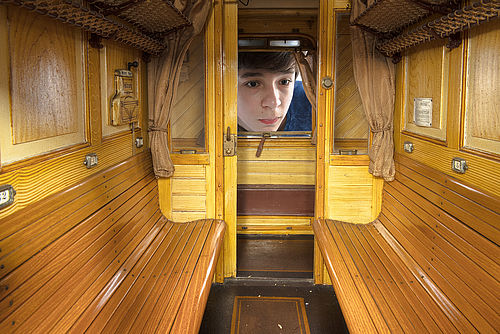
SDTB / C. Kirchner
The museum has a unique collection of historical railway models on a scale of 1:5, which were produced around the turn of the 20th century. Every door lock, every rivet, every sink is faithfully reproduced – from the steam locomotive to the funeral train. The interiors have been digitized with 360-degree cameras. From now on, users can take a virtual journey through time in the world of railways around 1900 – in 360-degree tours with a literary soundtrack.
Discover the digital story “Next stop: 1900!” on the platform Google Arts & Culture!
Highlights

Open passenger car, 3rd class
This original passenger car from the private railroad company Breslau-Schweidnitz-Freiburger Eisenbahn dates to 1843. It is one of only a few such vehicles still in existence from the early days of the rail travel – a truly special part of the collection. It shows how quickly German manufacturers departed from the model of horse-drawn carriages, developing designs specifically suited to the rails. Its open construction, without any weather protection at all, is a sign of the highly stratified class structure of the time.
1843

Prussian S 10 steam locomotive
This Prussian S 10 steam locomotive is one of the truly spectacular exhibits in the railroad collection. Between 1910 and 1914, a total of 202 locomotives of this class were built. Down to the 1930s, these robust locomotives were a mainstay of the rail network that spread out from Berlin across the North German Plain. Retired from service in 1934, our S 10 has had its boiler, cylinders, and cab cut open to show how a steam locomotive works.
Berliner Maschinen AG, 1911

E 19 streamlined electric locomotive
The increasing use of automobiles and airplanes in the 1930s put pressure on railroads in Europe and the USA. In response, rail vehicles capable of traveling at higher speeds were developed. They were often given streamlined panels to improve their aerodynamics, which gave them a modern look in addition to greater speed. The E 19 01 streamlined locomotive could go 180 km/h (the top speed allowed), making it the fastest electric locomotive on German rails. Just as in the 1930s, the front bears the emblem of an eagle with a swastika, thus illustrating the way in which outstanding technological innovations were instrumentalized by the Nazi regime.
AEG, 1938

Prussian P 8 passenger locomotive
At the end of Engine Shed I stands an oily, cannibalized steam engine of the P 8 class dating to 1919. The P 8 had a wide variety of uses. It could haul all but heavy express and freight trains. It was indispensable to rail traffic in Germany for a very long time. The last P 8 locomotives weren’t retired until 1972 (in East Germany) and 1974 (in West Germany).
Schichau-Werke, 1919

